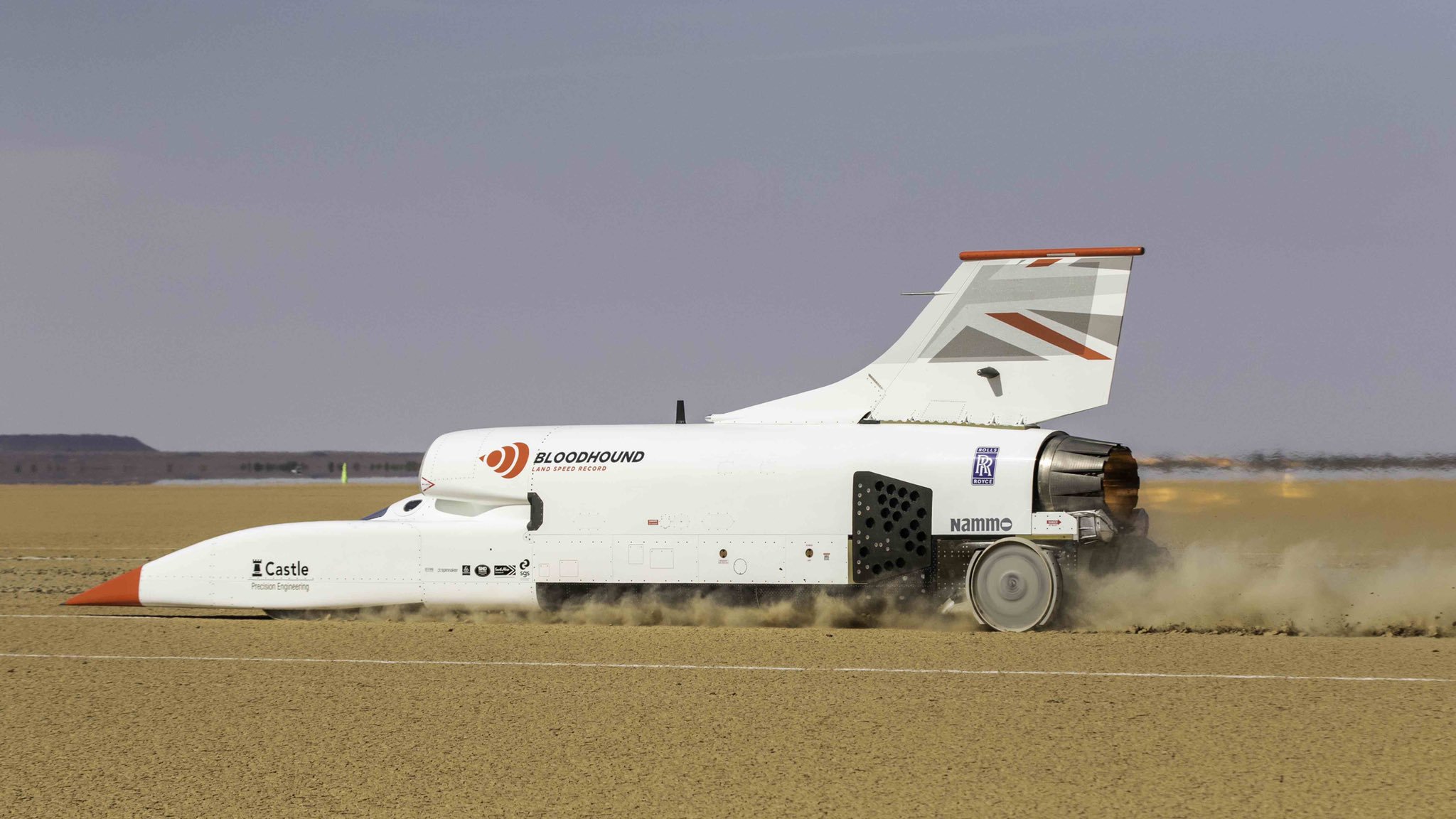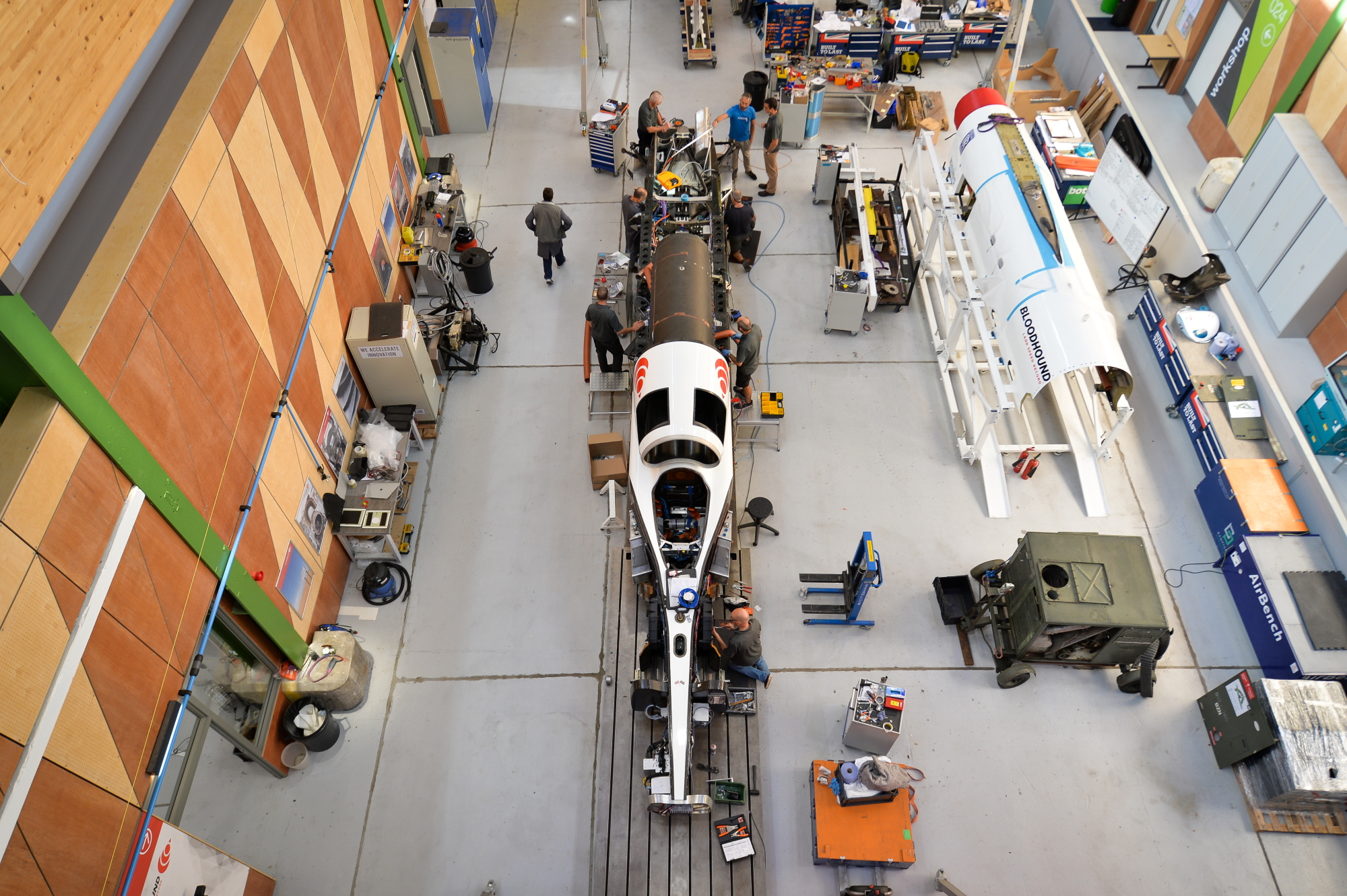Jet-Powered Car Roars Past 500 Mph. But Can This Beast Hit 1,000 Mph Without Destroying Itself?

An arrow-shaped car designed to reach supersonic speeds — it's outfitted with a jet engine and its own parachute braking system — just reached 501 mph (806 km/h) in tests in the Kalahari Desert in South Africa.
That's a ways off from pummeling past the speed of sound, or 761 mph (1,225 km/h), but it's one of many feats the car, called Bloodhound, will attempt over the next 12 to 18 months. In 2020 or early 2021, it will try to break the land speed record of 763 mph (1,228 km/h). That record was set by former Royal Air Force pilot Andy Green in the jet-powered Thrust SSC, in Nevada in 1997; Green is now behind the wheel of Bloodhound.
Once that's achieved, , Bloodhound may aim to reach a whopping 1,000 mph (1,609 km/h) — the top speed it's been designed for.
Related: See Photos of Wild Bloodhound Car Attempting to Crash the Sound Barrier
The record attempts will put incredible strain on the car. Any attempt to travel faster than sound creates high aerodynamic drag and a violent shock wave of rapidly expanding air that can be heard for long distances as a "sonic boom" — the same as the thunder heard when lightning heats air to supersonic speeds.

How a supersonic vehicle withstands the increased drag and shock wave, and how it stays stable and controllable at such tremendous speeds, are the critical challenges of its aerodynamic design. Aerodynamic challenge
Although traveling faster than sound is now routine for the fastest military aircraft, it's been achieved three times before on land, by another British jet car called Thrust SSC 22 years ago.
Get the world’s most fascinating discoveries delivered straight to your inbox.
"Thrust SSC was an incredible vehicle, and it achieved a remarkable thing of being the first car to go faster than the speed of sound," said one of Bloodhound's designers, Ben Evans, a University of Swansea aerodynamic engineer. "But the reality is that we did learn a lot about what not to do in the future."
Related: Supersonic! The 11 Fastest Military Planes
The result is that Bloodhound has been designed from scratch to travel faster than sound, and even to reach a top speed of Mach 1.3 — 1,000 mph (1609 km/h), about 237 mph (381 km/h) faster than Thrust SSC's record.
Bloodhound's long, narrow shape is very different from the relatively wide cross section of Thrust SSC, a design that the engineers say will allow Bloodhound to reach a much higher speed — about 650 mph (1,046 km/h) — before the increased drag and small shock waves in the air around it start to affect the handling of the car, he said.
When Bloodhound exceeds the sound barrier, its aerodynamics will become slightly easier to control, but it will still be trailing the large supersonic shock wave it creates.
A key question is how that shock wave will interact with the ground a few inches below the car — a problem not faced by supersonic jets.
"Does it just reflect back up off that surface? To what extent does it damage the surface? To what extent does it penetrate into that surface?" Evans asked. "These are all things that we have had to make best-guess assumptions on, and we will be validating those assumptions as we test the car."
Evans and his team gather data after each test drive from 200 pressure sensors placed around the body of Bloodhound and load sensors on each wheel. The data is processed to create detailed computer models, resulting in a kind of "virtual wind tunnel" that shows how the car behaves at different speeds, he said.
Desert track
The 7-ton Bloodhound car is powered by a Rolls-Royce EJ200 turbofan jet engine — the same engine used in the Eurofighter Typhoon aircraft.
Before the land-speed record attempt, Bloodhound will also be fitted with a powerful rocket engine to push it past the sound barrier.
Mark Chapman, the chief engineer of Bloodhound LSR, said his team was measuring the aerodynamic stresses on the car at higher and higher speeds, and testing and refining the braking systems, which include a parachute and air brakes.

Evans said bringing the car and its driver safely to a stop was as important as achieving supersonic speeds.
"At 1,000 miles an hour, if and when we get that far, we will be covering a mile in three-and-a-half seconds, and we have only got a 12.4-mile [20 kilometer] track," Evans said. "So one of the critical things at those really high speeds is, 'Are all our braking systems going to work?'"
A team of more than 300 people keep the test track free from stones and other obstacles, which would spell disaster for a vehicle traveling at hundreds of miles an hour.
The team will spend a further two weeks testing the car before South Africa's summer rains flood the track on Hakskeen Pan, a lakebed in the Kalahari Desert, and make it unusable for a few months.
"That is what makes it such a great surface," Chapman said. "Because of the fact that it floods every year, it levels out and then it just bakes hard … like concrete."
Both Chapman and Evans have been with the Bloodhound project since it started in 2007. Bloodhound was expected to attempt the land speed record in 2016. But the project ran short of money and almost folded until the company that owns it was bought last year by British car-parts millionaire Ian Warhurst.
- Hyperloop, Jetpacks & More: 9 Futuristic Transit Ideas
- Speedy & Swift: The Fastest Animals in the World
- Image Gallery: Breaking the Sound Barrier
Originally published on Live Science.

Tom Metcalfe is a freelance journalist and regular Live Science contributor who is based in London in the United Kingdom. Tom writes mainly about science, space, archaeology, the Earth and the oceans. He has also written for the BBC, NBC News, National Geographic, Scientific American, Air & Space, and many others.


